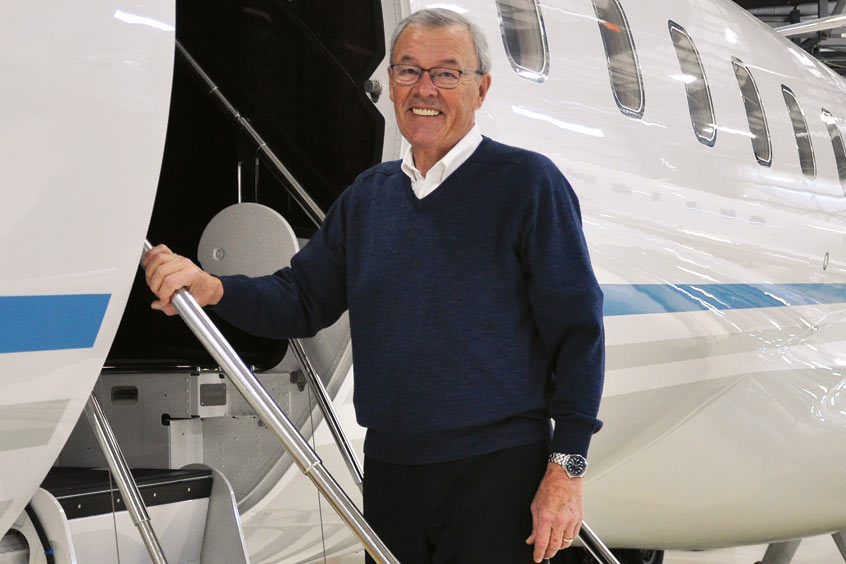ACE 2026 - The home of global charter.
• Flexjet Technical Services
Completions
• Flexjet Technical Services
Maintenance
BAN's World Gazetteer
• Canada The bimonthly news publication for aviation professionals.
The bimonthly news publication for aviation professionals.

For our Perspectives series, we talk to experienced business aviation industry professionals, who share with us their unique insights and offer a window into their world. This month's interviewee is John Gillespie, president of Flying Colours. His team have been fighting hard to maintain capacity during an exceptionally trying few months.
“Working through COVID-19 presented our North American facilities with numerous challenges as well as opportunities to demonstrate the versatility of our business. As an aircraft repair station, we were deemed an essential service by the Canadian and American authorities which meant we remained operational. To ensure business continuity we had to think differently about process, while ensuring that our customers employees, suppliers and executive team stayed safe.
This meant putting our heads together – which was difficult when a number of the senior executives had left before the annual spring break and had to quarantine for two weeks on their return – to establish new operating procedures and protocols that adhered to government guidelines. We implemented the obvious onsite precautions such as hand sanitisers, notices about symptoms, and requesting colleagues to maintain a distance from each other. We also chose to up the level of safety policies onsite.
We minimised movement between our buildings at both of our locations. Internal meetings were held on-line or on the phone, those that could, worked from home, and we ceased any travel between our facilities. Our team was incredibly flexible. It was hardest for the maintenance and interiors crews as by the very nature of the job they work in close proximity. We devised procedures that minimised distance and created our own internal face shields to give an extra layer of protection, all of which helped to mitigate the risk and increase workforce confidence.
Border closures and local lockdowns certainly kept our scheduling team busy as they became masters of planning for the expected and unexpected. Aircraft maintenance schedules moved; any aircraft due for paint immediately became a Canadian project as we had just opened our new high-tech paint shop in Ontario. Other aircraft stayed at our St. Louis facility that were originally destined for our Peterborough site. A number of customers brought their maintenance schedules forward while others cancelled completely. New customers came to us that we hadn’t worked with before. With the exception of paint work, our capabilities are mirrored at both sites, and this proved invaluable as we continued to meet customer deadlines.
Communication changed too, not just between colleagues, but with our customers and suppliers too. Where was Zoom before COVID-19 is a question we frequently ask ourselves. We now regularly hold progress meetings with customers on tablets and smart phones as we use online communication platforms as a means of showcasing project progress. The technology allows us to give customers a virtual tour, enabling them to see the developing project. In the short to near term we will keep this as a standard operational procedure. It saves time, money, and reduces the need to travel long distances, and for the main part is equally effective.
As the year progresses a growing interest in refurbishment options from individuals and new customers is apparent. Special mission projects are a key piece of our business and demand for combined VIP/medevac options is on the increase. Interestingly we’re seeing more requests for corporate shuttle conversions too from companies that need their executives and workforce to travel safely. A shuttle travelling directly to a destination with qualified passengers adds real value to business operations in the current climate.
The pipeline is looking good for the next twelve months and as these new projects come to fruition we suspect we’ll be working on less completions of new aircraft and generating more designs and engineering for converted interiors. New concepts we are researching include incorporating antibacterial surfaces into cabin interiors and flight decks, exploring technology to create switchless aircraft to reduce touch points, and focusing on equipping interiors with air purification systems. We are already installing the Aviation Clean Air proactive ionisation purification systems for aircraft owners in North America and know that will become a standard going forward.
The pandemic has demonstrated that business aviation is extremely agile and can adapt quickly to meet specific mission needs. We need to continue to deliver the message globally that business aviation is a valuable business tool that can help economies survive, provides a flexible alternative to commercial travel and delivers passengers to where they need to be safely and securely. These attributes will underpin travel for commerce and leisure going forward. Innovation, integrity and flexibility are our company watch words and they have been tested to the limit this year, but we recognise it’s a new normal and will continue to make the necessary adjustments to maintain, develop and deliver successful business operations.”